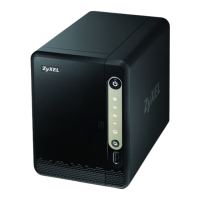Chapter 16 Backup Planner
NAS Series User’s Guide
271
Step 2 Source
Use this screen to specify where the files you want to backup are located.
Type Choose the backup type the NAS implements for the backup job.
Archive - This is a backup of the source folder in an archive format. Once you backup your files
in the target folder, you cannot access the files individually unless you have the extracting tool
used by the NAS. If there are existing files in the target folder prior to the NAS’s backup job, the
files remain undisturbed. You can also choose between the following types of archive:
• Full - The NAS does a fresh backup each time. This provides the most protection but also
requires the most storage space.
• Incremental - The NAS backs up new or modified files from the source folder since the last
backup. The first backup is a full backup. You can also do a full backup after several
incremental backups. Enter how many incremental backups the NAS runs before it
performs a full backup of the source folder in the Perform a full backup job after n
backup(s) field. You must keep the latest full backup to be able to restore the files later.
Synchronization - This does a backup of individual files. If you use this type, you cannot use the
Restore feature of the NAS. You can also choose between the following types of
synchronization:
• Publish- The NAS does a backup of individual files to the target folder without overwriting
existing files in that folder. It makes a copy of the source files.
• Mirror - The NAS deletes all data in the target folder before running the backup. It makes
the target folder identical to the source folder.
Rsync - This synchronizes individual files to another device that supports rsync. Rsync is open
source and provides incremental file transfers. It only sends the differences in the files through
the connection so it brings the remote files into sync very quickly.
• The NAS deletes all data in the target folder before running the backup. It makes the target
folder identical to the source folder.
• If you use this type, you cannot use the Restore feature of the NAS.
Purge Policy This field is not available when you set the backup type to Synchronization or Rsync.
The NAS maintains the files that have been included in your backups. However to save hard
disk space, you can choose to delete files that have been included in previous backups.
•Select Keep all old backups to store all files that have been included in previous backups.
• If you want to store a certain number of backup files, select Keep the last n backups. Enter
a value (n) from 1 to 30 to specify how many backups the NAS stores. All backup files older
than the last one are deleted. You will not be able to recover files that existed (only) in
those previous backups. Select this if backup space is limited and recovery of old files is not
important.
• If you want to store all backups for a certain time period, select Keep old backups for n
day(s). Enter a value (n) from 1 to 3650 to specify how many days the NAS stores all backup
files. After this day has expired, all backup files will be deleted.
Next Click this to go to the next step.
Cancel Click this to close the screen without saving.
Table 151 Backup Planner > Backup: Add Job Step 1 Properties (continued)
LABEL DESCRIPTION

